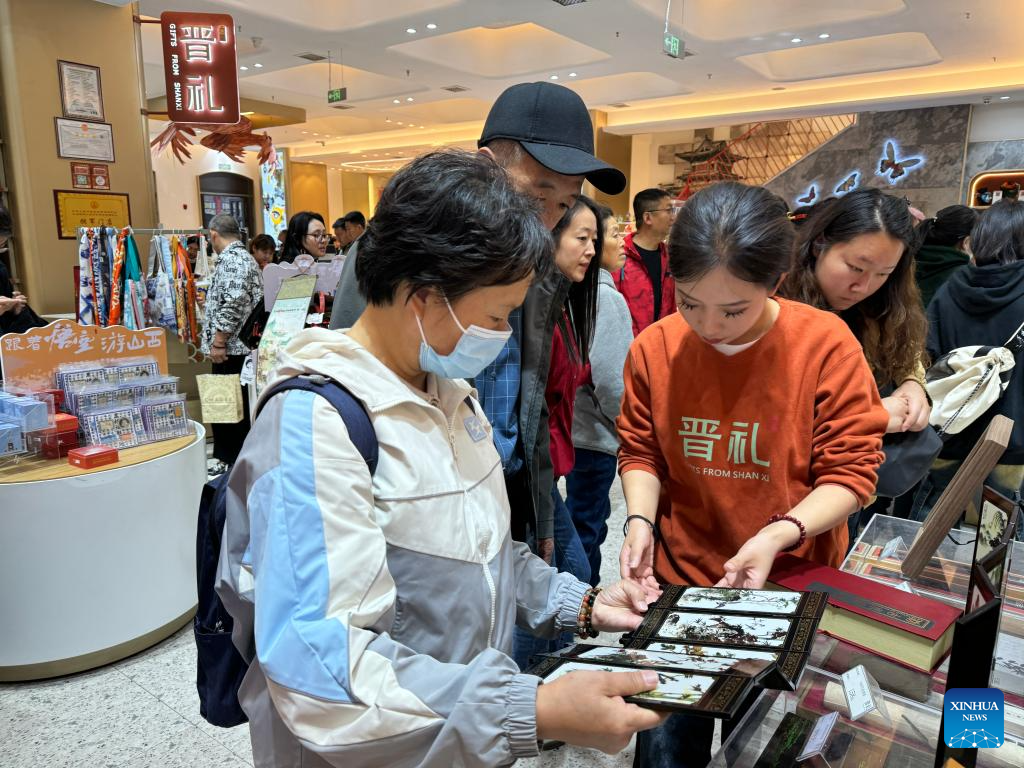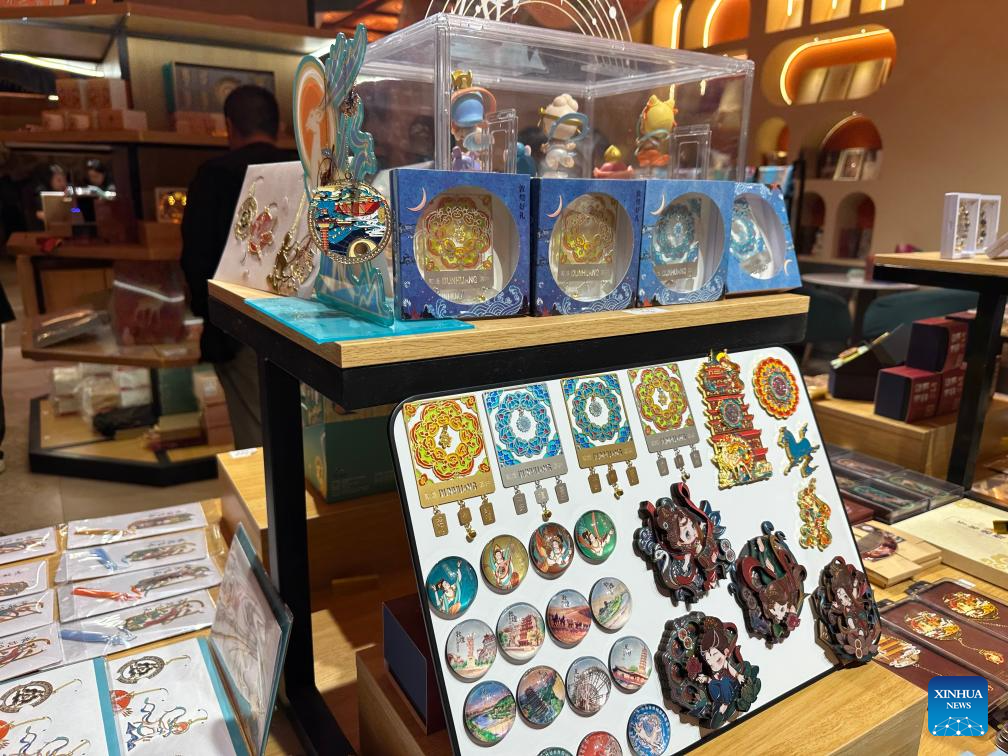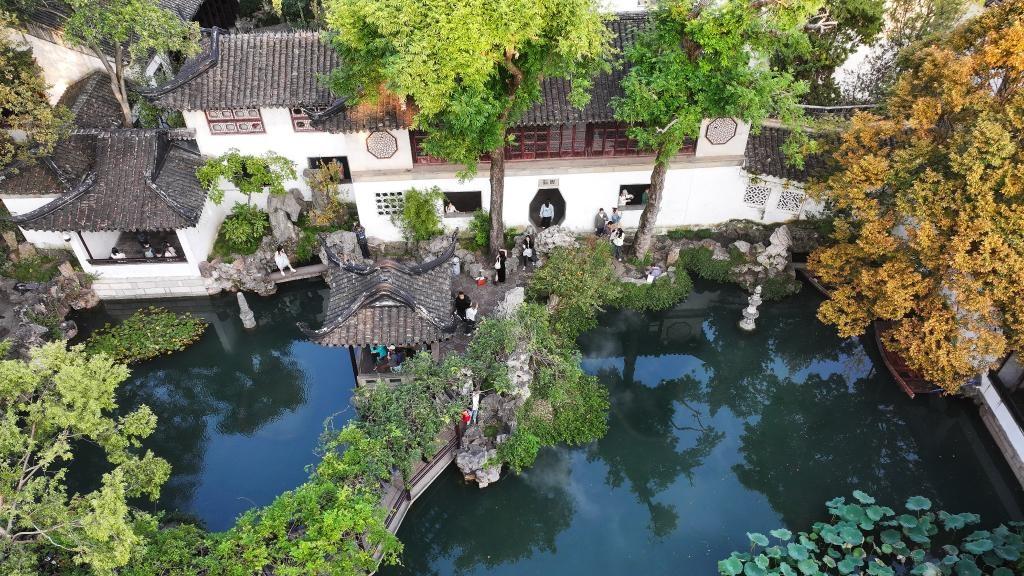Behind the craze for creative cultural products

Tourists select creative cultural products at a gift shop in Taiyuan, north China's Shanxi Province, Oct. 13, 2024. (Xinhua/Wang Xuetao)
TAIYUAN, Oct. 30 (Xinhua) -- After a nine-day tour in north China's Shanxi Province, one man is determined to "bring home" the grand pagodas and exquisite sculptures that took his breath away.
"I have spent more than 1,000 yuan (140 U.S. dollars), which is about a tenth of my holiday budget, on souvenirs!" said the 30-year-old visitor surnamed Ma.
Shanxi is renowned for its ancient architecture and is home to over 28,000 ancient structures. Its popularity has been boosted recently by the phenomenal video game "Black Myth: Wukong," which is based on the Chinese classic novel "Journey to the West."
"I was fascinated by the ancient architecture, and the fridge magnets were equally amazing," Ma said. "Each city has its unique creative cultural products. They are like miniatures of the attractions. For me, buying these keepsakes is like preserving the beauty of this trip forever."
Shanxi Province launched "Following Wukong to visit Shanxi" this summer, an activity that encourages tourists to "check in" at the filming locations of the video game. It is due to end on Thursday.
Shortly after the launch, a Monkey King creative product shop opened on the business street in the heart of Taiyuan. It has since been packed with enthusiastic customers vying for products like fridge magnets, notebooks and playing cards.
Yang Liu, with the shop, told Xinhua that their intention of opening the shop was to take a chance and promote the culture and tourism of the province. Since September 27, their sales have reached 200,000 yuan.
Shanxi is not alone. Across China, various cultural and creative products are now sought-after mementos or gifts for friends, with their images going viral on social media: necklaces that draw inspiration from traditional brush painting in the Palace Museum; wooden combs in the shape of traditional Chinese musical instruments; vanity mirrors bearing patterns resembling the one on display in the Luoyang Museum of central China; keyboards with the colors of the famous Dunhuang murals and the nine-colored deer image...
According to a report by Zhiyan Consulting, the market size of China's cultural and creative products reached 16.38 billion U.S. dollars in 2023, a year-on-year increase of 13.09 percent. In 2020, the sector's market size accounted for 10.67 percent of the global total, and by 2023 it had risen to 11.56 percent.
One fridge magnet capturing the elaborate details of a superbly delicate empress crown from ancient China, a treasured piece from the National Museum of China (NMC), has emerged as an internet sensation and sparked a buying spree.
Aspiring collectors even start queuing from 6 a.m. outside the museum for their chance to snag the memento. Many exchange tips on how to obtain the popular magnet on social media.
In just three months since its launch, nearly 80,000 magnets have been sold, boosting sales of the entire series of empress crown memorabilia including key chains, furry toys and popsicles, with a total revenue exceeding 10 million yuan, even when facing production capacity constraints. The current daily production capacity for magnets has reached 3,000 units, with potential for further increase to meet growing market demand.
Liao Fei with the management and development department of NMC disclosed that the design was inspired by social media, where they saw a lot of visitors posting photos of the empress crown.
Head of a seven-member team, he said: "We always watch the exhibitions and search on social media to see what tourists like."
They are also constantly improving the products. Liao found that while there were tips on social media on how to obtain such a fridge magnet, few talked about its unique features. So they decided to make it more innovative.
On September 27, an AR fridge magnet featuring the empress crown was released, which could be "worn" by the buyer on a mobile phone screen after a scan of the QR code. More than 2,300 such magnets were sold within two hours after its release.
"In recent years, there has been a boom in the number of such creative products that are of use in various aspects of people's life," said Song Yanli, a saleswoman at the official gift shop of the Dunhuang Museum in northwest China's Gansu Province.
Noting that buyers today are knowledgeable enough to discern all the cultural elements adopted in the design, the 32-year-old said that they must develop more products to keep pace with public demand.
"With the improvement of people's living standard, the consuming behavior of youngsters is changing," said Mao Jinhuang, a professor with the School of Economics at Lanzhou University. "They are no longer satisfied with simple material consumption but pay more attention to the purchase experience."
He believed that while the creative cultural products could offer emotional value to the customers, the craze for them also reflected young people's love for and interest in Chinese traditional culture.
According to China's National Bureau of Statistics, the added value of cultural and related industries in 2022 stood at 5.38 trillion yuan, more than 15 fold of that in 2004, with the share of that in GDP increasing from 2.13 percent to 4.46 percent in the 18 years.
Bu Xiting, associate researcher with the School of Cultural Industries Management at the Communication University of China, noticed that creative cultural products are becoming a new growth point of tourism consumption. "They have increased the income at tourist attractions, propelled the development of relevant industries and become a driving force to promote local economic growth.
In the first half of this year, China's domestic tourist trips reached 2.72 billion, with total tourism expenditure amounting to 2.7 trillion yuan, marking year-on-year increases of 14.3 percent and 19 percent, respectively.
"With the deepened integration of creative cultural products and the tourism industry, it is expected that such products could play a more important role in boosting the high-quality development of the industry in the future," Bu said.

Creative cultural products are seen at a gift shop in Dunhuang, northwest China's Gansu Province, Sept. 21, 2024. (Xinhua/Zhang Wenjing)
Photos
Related Stories
- Contemporary Chinese calligraphy, fiber art exhibition opens in Bulgaria
- 2nd World Conference of Sinologists opens in east China
- China strengthens standard Chinese handwriting education
- Summit attendees urge more cultural exchange, cooperation between two sides of Taiwan Strait
- Mainland official meets with Taiwan cultural circle personages in Beijing
Copyright © 2024 People's Daily Online. All Rights Reserved.









